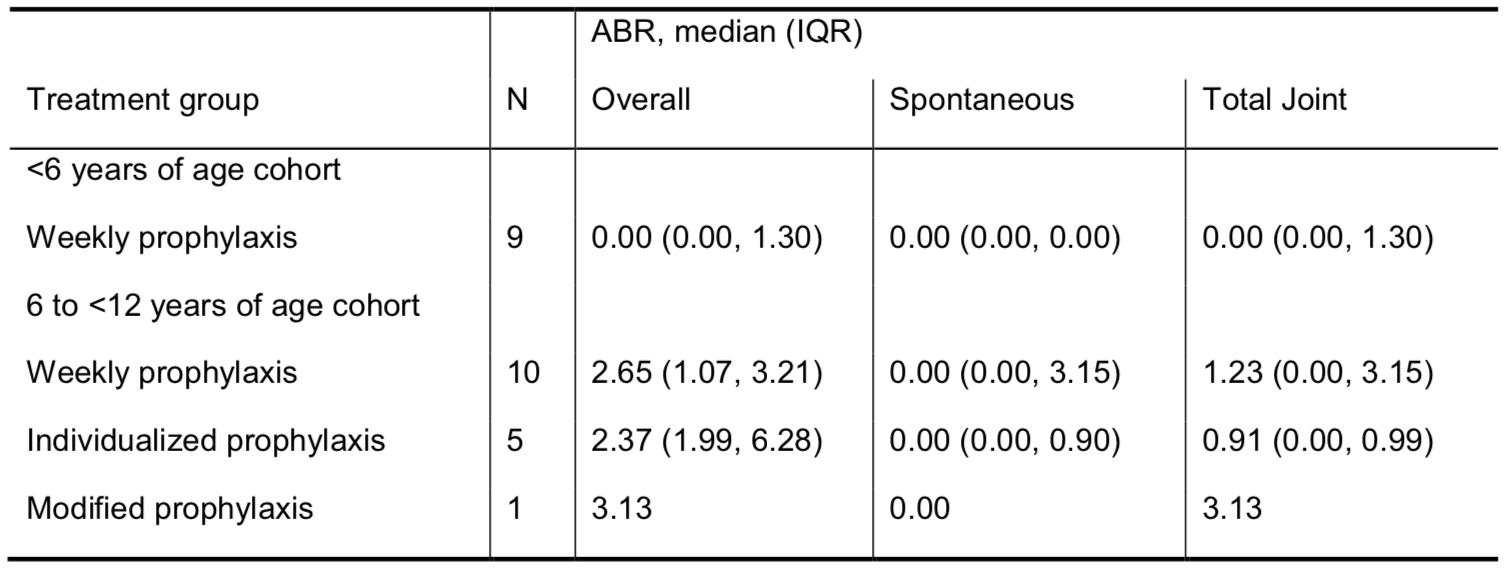
Leaderboard Ad

Year:
-
Grants:
NHF-Takeda Clinical Fellowship
Dr. Angela Weyand is a pediatric hematology/oncology fellow at The University of Michigan, Mott Children's Hospital. She is a native of Kansas City, Kansas and a graduate of Northwestern University in Evanston, Illinois. Dr. Weyand attended medical school at the University of Michigan and completed her pediatrics residency at the University of Washington/Seattle Children's Hospital. As a NHF-Baxalta Clinical Fellow, she will receive dedicated clinical training in the care of patients with disorders of hemostasis, as well as continuing her current research projects investigating genetic modifiers of coagulation in a zebrafish model. Dr. Weyand will be seeing patients with hemophilia and other hemostatic disorders under the mentorship of Dr. Steven Pipe and Dr. Jordan Shavit, and Dr. Pipe will include her in the management and interpretation of test results in their special coagulation laboratory. Dr. Weyand's long term goals are to further the field of coagulation through translational research and to provide the highest level of comprehensive clinical care to patients with hemophilia and coagulation disorders.
A Feasibility and Usability Study of a Nursing-Orchestrated, Customized Immersive 3 Dimensional Virtual Reality Environment in Children with Hemophilia Undergoing Routine Intravenous Procedures
Year:
-
Grants:
Nursing Excellence Fellowship
The purpose of this project is to request support for the development of a Virtual Reality Environment (VRE) study program for pediatric patients diagnosed with hemophilia. The VRE program proposed was developed and created for children and includes interactive imagery, character avatars and colorful visual environments. This VRE program will be deployed by the child in a clinical setting and is proposed to help decrease, anxiety and needle phobia during intravenous factor infusions. Outcome measures will include an anxiety scale before and after each infusion, collection of biophysiologic data, pain score and visual analogue evaluation. The expected result of this nursing project is to monitor the use of a VRE in the pediatric population with a reduction of fear, anxiety and pain experienced with intravenous factor infusions.

Pavan K. Bendapudi
Year:
-
Grants:
NHF-Takeda Clinical Fellowship
At the time of his application, Dr. Pavan Bendapudi was finishing his third year of adult hematology/oncology training at the combined Dana Farber Cancer Institute- Massachusetts General Hospital (DFCI-MGH) fellowship program. After finishing his medical degree at Stanford University, he did his residency in internal medicine at MGH, where he developed a strong interest in bleeding and clotting disorders. This led him to complete an additional fellowship in blood banking and transfusion medicine through the Harvard Combined Transfusion Medicine Program, where he was the first graduate of his residency program to have pursued additional training in this area.
As a hematology fellow, Dr. Bendapudi provided care to patients at the hemostasis clinic at Beth Israel Deaconess Medical Center, and pursued additional research opportunities in the labs of Dr. Robert Flaumenhaft and Dr. Bruce Furie. Dr. Bendapudi received a Mentored Research Award from the Hemostasis and Thrombosis Research Society (HTRS) and will join the faculty at Massachusetts General Hospital as an instructor with an appointment in the Division of Hematology. While a NHF-Baxalta Clinical Fellow, Dr. Bendapudi will participate in the Comprehensive Hemophilia Clinic at Children's Hospital Boston, attending all clinical sessions and training under the mentorship of Dr. Ellis Neufeld. Dr. Bendapudi will continue expanding his training, along with a focus on the transition from pediatric to adult hemophilia care.

Anti-fibrinolytic Strategies to Decrease Bleeding in Hemophilic Arthropathy
Year:
-
Grants:
Career Development Award
Hemophilic Arthropathy
Pain
Dr. von Drygalski's research focuses on better understanding the mechanisms operating the anti-fibrinolytic system and how this process works in patients with hemophilia and specifically with joint bleeding. Accelerated fibrinolysis and clot instability are becoming increasingly recognized as contributing factors to bleeding in hemophilia. One important molecule that prevents fibrinolysis is called TAFI (Thrombin Activatable Fibrinolysis Inhibitor). Dr. von Drygalski will be studying the dual anti-fibrinolytic and anti-inflammatory functions of TAFI in hemophilia arthropathy and develop a therapeutic TAFI-based approach to improving the efficacy of FVIIa based bypassing strategies for acute bleeding and joint protection. Her mentors and collaborators are John H. Griffin, PhD, Laurent O. Mosnier, PhD and Martin Lotz, MD, distinguished researchers at UCSD -The Scripps Research Institute. Dr. von Drygalski received her M.D. from the Universities of Erlangen/Nurnberg and Munich in 1995 and her Pharm.D. from the University of Munich in 1988. She joined the faculty in July 2011 as Assistant Clinical Professor at UCSD and Director of the Adult Hemophilia and Thrombosis Treatment Center, Division of Hematology/Oncology, Department of Medicine. She also has an appointment as Adjunct Assistant Professor at the Scripps Research Institute (TSRI). The funding for this award is made possible thanks to a generous grant from Novo Nordisk.

Mechanoregulation of von Willebrand Factor Inhibition and Activation
Year:
-
Grants:
Rueleen Kapsch
Judith Graham Pool Postdoctoral Research Fellowship
Von Willebrand Disease
Per Dr. Fu, the JGP provided her with the opportunity to work on hemophilia, as well as von Willebrand disease. After the completion of her JGP project, Dr. Fu remained in the bleeding disorder field.
A Comprehensive and Unbiased Screen of ADAMTS13 Substrate Specificity
Year:
-
Grants:
Judith Graham Pool Postdoctoral Research Fellowship
Von Willebrand Disease
Per Dr. Kretz, the JGP award came at an ideal point in his career. Through the JGP Program, the support of the NHF plays an important role in developing young and promising research in hematology and bleeding disorders. He is truly grateful for the support of the NHF during his training and considers the award to be an important moment in his career.
The work supported by the JGP Fellowship led to two publications, one in PNAS and another in Scientific reports.

Exercise Versus DDAVP in Patients with Mild Hemophilia A - Which Is Better and Do They Work Additively in Improving Hemostasis?
Year: 2016
Grants:
Physical Therapy Excellence Fellowship
Preliminary work done by Dr. Riten Kumar and colleagues has documented that moderate intensity exercise is associated with a significant improvement in multiple coagulation parameters in post-adolescent males with mild-moderate hemophilia A. As a continuation to our previous work, we now hope to compare the impact of moderate intensity exercise to DDAVP on laboratory coagulation parameters in post-adolescent males with mild hemophilia A. We also hope to investigate the impact of sequentially administering these interventions on hemostatic indices. Our over-arching hypothesis is that increase in coagulation parameters (particularly FVIII:C) with moderate intensity aerobic exercise would be non-inferior to DDAVP. We additionally hypothesize that we will appreciate an additive effect of sequentially administering clinical implications for patients with MHA. It may negate the use of DDAVP pre- exercise and could potentially lead to clinicians advising patients to appropriately warm-up (e g running), to raise their FVIII/VWF levels prior to undertaking more rigorous sports. It will also lay the foundation for future studies investigating the interaction between aerobic exercise and hemostasis in subjects with bleeding disorders these interventions. Should our hypothesis be correct, our study would have significant clinical implications for patients with MHA. It may negate the use of DDAVP pre-exercise and could potentially lead to clinicians advising patients to appropriately warm-up to raise their FVIII/VWF levels prior to undertaking more rigorous sports. It will also lay the foundation for future studies investigating the interaction between aerobic exercise and hemostasis in subjects with bleeding disorders.
Molecular Basis of Procofactor to Cofactor Activation in FVIII
Year:
-
Grants:
Bob and Margaret Carton
Judith Graham Pool Postdoctoral Research Fellowship
Hemophilia A (Factor VIII/F8)
Dr. Parthasarathy's research will tackle two important biological issues in coagulation - namely how procofactor FVIII converts to the active cofactor form (FVIIIa) and binds to IX and X, and the location of FVIII in generating the active Xase complex. Results from this study will provide molecular and biochemical insights into the role of FVIIIa in regulating hemostasis and further elucidate the interactions between coagulation complexes. Dr. Parthasarathy obtained his Masters in Biotechnology from Jawaharlal Nehru University in New Delhi, India and received his Ph.D. in Biochemistry from the University of Kansas in 2011. He has been a postdoctoral researcher in the lab of Dr. Rodney Camire at The Children's Hospital of Philadelphia since July 2011. This award has been made possible through a generous donation from Hemophilia of Georgia, Inc.
Mothers' Perceived Vulnerability, Protective Behaviors and Stress in Relation to Their Sons with Hemophilia
Year: 2016
Grants:
Social Work Excellence Fellowship
It is unknown if there are differences in attitudes and behaviors between mothers of sons with hemophilia who have a known family history of hemophilia compared to mothers without a known family history. To capture these differences, this study will measure mothers' perceived vulnerability of their sons, protective behaviors toward their sons and reported stress in the mother-son relationship. Sixty mothers will complete the following surveys: Parent Protection Scale, Child Vulnerability Scale and Parenting Stress Index/Short Form. The results of this data will influence clinic social work practice in the comprehensive care model at hemophilia treatment centers.

Lindsey A. George
Year:
-
Grants:
NHF-Takeda Clinical Fellowship
Dr. Lindsey George is a pediatric hematology/oncology fellow at The Children's Hospital of Philadelphia. As a NHF-Baxalta Fellow, Dr. George will receive clinical training under the mentorship of Dr. Leslie Raffini, Director of the Hemophilia Treatment Center at The Children's Hospital of Philadelphia. She will also be pursuing training in translational science in coagulation molecular biology and gene transfer in the laboratory of Dr. Katherine High. Dr. George graduated from Cornell University and received her M.D. from the State University of New York at Buffalo School of Medicine. She did her pediatric residency and chief residency training at Weill Cornell Medical School, where she had the fortunate opportunity to interact with Dr. Donna DiMichele. Dr. George has a longstanding interest in the intricacies of coagulation physiology and the incorporation of that understanding to the clinical care of patients with coagulation disorders. Dr. George hopes to contribute to the improvement of treatment for patients with bleeding and thrombotic disorders through a career in translational research.

Stacy E. Croteau
Year:
-
Grants:
NHF-Takeda Clinical Fellowship
Dr. Stacy Croteau received her B.S. and M.S. in Neuroscience, and her M.D. at Brown University, where she was awarded AOA. She was resident and chief resident in pediatrics at Boston's Children's Hospital and received the Sydney Farber Award. At the time of her application, she was a third year Pediatric Hematology-Oncology fellow at Boston Children's Hospital and was accepted on faculty at Harvard as an instructor in pediatrics. Her research during fellowship was on a clinical review of Kaposi form Angioendotheliomas which resulted in 2 publications in the Journal of Pediatrics (2013, and 2014) as well as an ASH Trainee Research Award. She was the first fellow to complete the BCH-Novartis Clinical Fellowship in Early Oncology Drug Discovery. While a NHF-Baxalta Clinical Fellow, Dr. Croteau will be mentored by Dr. Ellis Neufeld, Medical Director of the Boston Hemophilia Center. She also has plans to pursue clinical research in “rationally designed personalized prophylaxis regimensâ€.

Maissaa Janbain
Year:
-
Grants:
NHF-Takeda Clinical Fellowship
Dr. Maissaa Janbain was born in Lebanon and received her M.D. degree from the Lebanese University in 1999. After completing her internship and residency in Internal Medicine in Lebanon, she came to the U.S., where she completed a second internship and residency in internal medicine at Case Western Reserve University in Ohio. She then entered the Hematology/Oncology Fellowship program at Tulane University, which she is scheduled to complete in 2015. Dr. Janbain has developed a strong interest in coagulation medicine and has spent much time receiving guidance from her mentor Dr. Cindy Leissinger, Director of the Louisiana Comprehensive Hemophilia Center. In conjunction with Dr. Leissinger, she has worked on clinical research projects for porcine rFVIII and FXIII. Dr. Janbain has not only had several research abstracts accepted but also presented at several professional meetings. She is interested in global assays and thromboelastometry. She has been applying this technique to assess FVIII and VWF in pregnant women.
The Use of High Resolution Power Doppler Musculoskeletal Ultrasound (MSKUS) in Bleeding Disorders
Year:
-
Grants:
Nursing Excellence Fellowship
The project's ultimate goal is to expand nursing knowledge of hemarthrosis/soft-tissue bleeding detection by presenting our HTC's experience with how MSKUS improves accurate diagnosis and guides treatment of bleeding and other pain etiologies. By completing the retrospective data review, we hope that the experience of a large center HTC spanning both adults and pediatrics will be made available. We believe that the current restraints of MSKUS implementation include cost of equipment, operator certification, and quality of interpretation to guide interventions. Therefore, partnering with radiology experts may be helpful for other HTCs around the country when using this modality in the future. Our center's experience will show that collaboration with radiologists for real-time imaging is successful with nursing evaluation and coordination.
Quantitative research into people with hemophilia and caregiver perceptions of pre-filled solvent syringe (MixPro®)
Year: 2015
Grants:
Bleeding Disorders Conference
New Products
Objective:
People with hemophilia (PWH) commonly self-infuse at home, and can provide valuable insights into device attributes. While Novo Nordisk initially launched recombinant activated FVII (NovoSeven® RT) with vial adaptors, these were replaced with prefilled diluent syringe (MixPro®) in 2013; rFVIII (NovoEight®) launched with MixPro® in the US in 2015. This market research study assessed PWH and caregiver perceptions and preferences between MixPro® and vial adaptors (original device).
Methods:
A market research study was conducted in Fall 2014, comprising 30-minute face- to-face interviews. In total, 38 PWH (≥18 years) and 29 caregivers of children with hemophilia participated in the study, from Italy (n=20), Spain (n=20) and the US (n=27). Participants were eligible if they regularly home-infused replacement factor, and were excluded if they had ever used rFVIIa or were already familiar with MixPro®.
Summary:
The mean age of participants was 27 years. Most had hemophilia A (84%) with the remainder having hemophilia B (16%), more received prophylaxis (73%) than on demand (27%), and most received rFVIII (73%). Other participants were treated with FIX or plasma- derived FVIII. One PWH had inhibitors and was treated with activated prothrombin complex concentrate. MixPro® was clearly and consistently preferred over vial adaptors, both overall and based on key criteria. Overall, 96% were confident that they could use the system correctly, 73% thought it was intuitive to use, and 93% thought it was easy to learn. When asked to rank 18 defined benefits in order of importance, ‘low contamination risk’ was deemed the most important; the only criteria where MixPro® was not superior were related to verifying mixed factor had been drawn into the syringe. MixPro® was most associated with being: quick, easy, and convenient to use; portable; and overall user friendly. Caregivers placed more emphasis on a device being suitable for a person with less strength, while PWH were more interested in portability and convenience. Results were generally consistent across sub- populations: PWH vs caregivers, and those treated on demand vs prophylaxis.
Conclusions:
MixPro® demonstrated clear advantages over vial adaptors, based on feedback from PWH and caregivers, with respondents reporting it easy to learn and use, and confident they could use it correctly. The results affirm the importance of continuing to innovate on devices in collaboration with the hemophilia community.
Personalization of Treatment Regimens for Physically Active Patients: A Comparison of Factor VIII and Extended Half-life Treatment Regimens
Year: 2015
Grants:
Bleeding Disorders Conference
New Products
Pharmacist/Provider Collaboration needed to Optimize Dosing Regimens in Order to Reduce Bleed Rates in Hemophilia A Patients on Prophylaxis Regimens
Year: 2015
Grants:
Bleeding Disorders Conference
Collaboration/Team Models
Objective:
Highlight the importance of collaboration in addition to dose, frequency, and PK data to personalize regimens in order to minimize bleed rates in Hemophilia A patients on prophylaxis.
Methods:
Dose and bleed data was collected and reviewed from January 1, 2015 through March 31, 2015 for all moderate to severe hemophilia A patients on prophylaxis regimens with traditional acting products in 2 regional bleeding disorder hubs. Units per kilogram per dose, units per kilogram per week, and spontaneous bleed rate were calculated from data. If reporter was unsure of bleed origin, it was counted as a spontaneous bleed.
Results:
Region X had 34 and Region Y had 40 patients that met the inclusion criteria for review. The average dispensed dose for Region X was 43.89 units per kg per dose. For Region Y, it was 35.47 units per kg per dose; a difference of 8.42 units per kg per dose. Due to varying frequency orders, regimens were further calculated in units per kg per week. Region X’s average was 121.38 units per kg per week and Region Y’s was 96.98; a difference of 24.4 units per kg per week. Patients in Region X reported zero spontaneous bleeds during the study period. Patients in Region Y reported 16 spontaneous bleeds from 12 unique patients. Of these patients, target joints were cited as contributing factors with 8 of the 16 bleeds. When appropriate, prescribers were notified and collaboration on regimen adjustments was made. Pharmacokinetic data was inconsistently available.
Conclusion:
Zero spontaneous bleeds should be the goal for hemophilia A patients on prophylaxis. Small changes in dose or frequency can make significant changes in outcomes. Many variables impact bleed rates and doses vary widely. There is the potential for refining dosing algorithms based on a more personalized approach that includes close and careful monitoring of trough levels, patients activity level, bleed pattern and response to changes in treatment plans. This individualized approach would require collaboration between patients, prescribers, and pharmacies. Such an approach can have huge and long-term beneficial effects on pharmacoeconomic, clinical, and quality of life outcomes. Data collected from this study may further assist pharmacists with influencing prescribers to consider pharmacist obtained bleed data and/or obtain and provide PK data so they can assist with regimen adjustment recommendations based on their assessments. With increasing payer pressure and the introduction of longer acting products, this collaboration will become even more imperative.
Cost of Treating Thrombotic Events in a US Population of Von Willebrand Disease Patients
Year: 2015
Grants:
Bleeding Disorders Conference
Biomedical/Coagulation Research
Background:
Current available factor replacement therapy (FRT) for von Willebrand Disease (vWD) contains FVIII. Thromboembolic events (TEE) are a small but serious risk in patients with elevated FVIII levels as a result of accumulation from repeated doses of FRT (Manucci, 2004).
Aim:
To assess the total medical cost incurred in one year of treating TEEs in vWD.
Methods:
This retrospective database analysis utilized the Marketscan®Database, a US medical claims database, from Jan 2006 to Mar 2014. Patients with inpatient diagnosis for a TEE (ICD-9 code for venous thromboembolism [VTE], myocardial infarction [MI], ischemic stroke [IS], etc.) were identified, with the first inpatient TEE visit defined as the index date (ID). VWD diagnosis (286.4) was required prior to ID and ≥12 month continuous enrollment both prior and post ID. Direct medical costs of TEE management in the first year were estimated for inpatient and outpatient settings. The subset of VWD patients prescribed FRT prior to ID was also described. Costs were adjusted to 2013USD using the medical consumer price index.
Results:
One hundred fifty-three vWD subjects were identified with an inpatient TEE. Mean age at the ID was 56 years (2–94 yrs) and 69.9% were female. Median annual cost and range associated with treatment of TEEs was $21,166 ($1,300–$867,710). VTE and IS were the most common TEEs (36.0% ≥1 VTE, $24,338 ($1,063–$235,090) and 32.7% ≥1 IS, $11,326 ($1,300–$368,550), respectively). Patients prescribed FRT (n=12) had a median annual cost of $64,648 ($4,690–$137,705) for TEE treatment.
Conclusion:
This is the first study to estimate the total cost associated with management of TEEs in vWD. TEEs are a burden to the healthcare system and are potentially life- threatening. A vWD treatment option that can avoid the risk of FVIII accumulation may benefit vWD patients at risk for TEEs.

In vivo Imaging of Bleeds in Hemophilia B
Year:
-
Grants:
Judith Graham Pool Postdoctoral Research Fellowship
Hemophilia B (Factor IX/F9)
Hemophilic Arthropathy
Pain
Dr. Chappell's research project will develop a model for characterizing bleeding in hemophilia and particularly in joints. Using mouse models of hematoma formation and knee joint bleeding, Dr. Chappell will use 3D fluorescent imaging technology in "living" hemophilia B mice to better trace bleeding over time- from induction of a bleed to its resolution. This project will provide additional insights on the basic science underlying hemophilic bleeds, not to mention the optimal interventions and timing of treatment to potentially prevent damage caused by bleeds. Dr. Chappell earned her Ph.D. in Pharmaceutical Sciences from UNC Chapel Hill in 2013. She will pursue her research under the mentorship of Dr. Dougald Monroe, Professor in the Division of Hematology/Oncology, UNC School of Medicine and the UNC McAllister Heart Institute.
Interim results of the B-YOND study evaluating long-term safety and efficacy of recombinant factor IX Fc (rFIXFc) in children with severe hemophilia B
Year: 2015
Grants:
Bleeding Disorders Conference
Clinical Research/Clinical Trials
Objective:
The ongoing rFIXFc extension study, B-YOND (clinicaltrials.gov #NCT01425723) , evaluates the long-term safety and efficacy of rFIXFc for the treatment of severe hemophilia B. Here we report interim safety and efficacy data for children aged <12 yrs enrolled in B- YOND.
Methods:
Upon completing Kids B-LONG, eligible subjects could enroll in one of the 3 prophylactic treatment groups in B-YOND: weekly (20 to 100 IU/kg every 7 days), individualized (100 IU/kg every 8 to 16 days, or twice monthly), or modified (a prophylaxis regimen different from weekly or individualized prophylaxis). Subjects could change treatment groups at any point in the study. The primary endpoint was development of inhibitors. Secondary outcomes included annualized bleeding rate (ABR) and rFIXFc exposure days (EDs).
Summary:
At the time of the interim data cut (17 October 2014), 23 subjects had completed Kids B-LONG; all enrolled in B-YOND (<6 yrs of age cohort, n=9; 6 to <12 yrs of age cohort, n=14). As of the interim data cut, 2 subjects had completed and 21 subjects continued in B-YOND (median time on study: 47.7 weeks). From the start of Kids B-LONG to the B-YOND interim data cut, the median time on rFIXFc was 95.3 weeks, with a median of 94 cumulative rFIXFc EDs. All subjects were on weekly prophylaxis in Kids B-LONG; 5 subjects changed treatment groups at the start of or during B-YOND. In the weekly prophylaxis group, the median (IQR) average weekly prophylactic dose was 64 (52, 66) IU/kg and 63 (59, 64) IU/kg in the <6 yrs and 6 to <12 yrs of age cohorts, respectively. The median (IQR) dosing interval among subjects on individualized prophylaxis was 10 (10, 11) days. As of the interim data cut, no inhibitors were observed, there were no reports of anaphylaxis or serious hypersensitivity reactions associated with rFIXFc, and no thrombotic events. Adverse events were typical of the pediatric hemophilia B population; no subject discontinued the study due to an adverse event. Median ABRs were low in both age cohorts (Table). Overall, 95% of bleeding episodes were controlled with 1 or 2 infusions.
Conclusions:
Interim data in children with severe hemophilia B participating in B-YOND confirm the long-term safety of rFIXFc and the maintenance of a low ABR with extended-interval prophylactic dosing.

The impact of missing one or two infusions per month: a comparison of rFVIII and rFVIIIFc regimens
Year: 2015
Grants:
Bleeding Disorders Conference
Quality of Life/Outcomes Research

